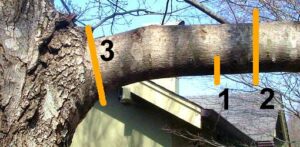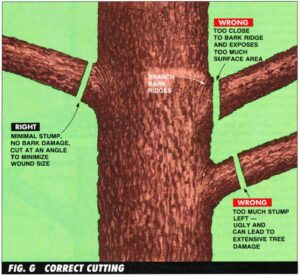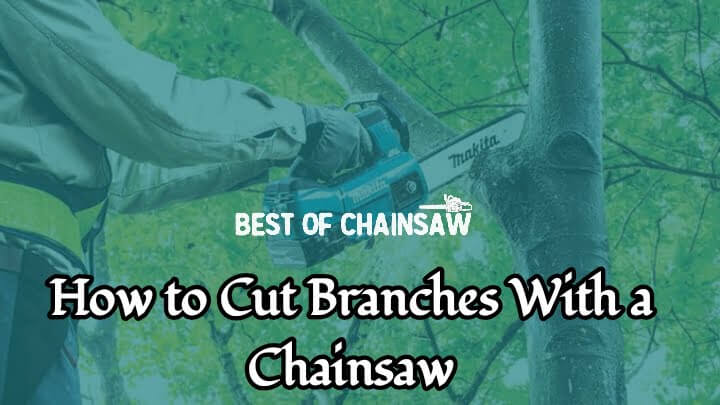If you want to cut branches with a chainsaw.
But not sure exactly how to do it?
Then, you have landed on the right page.
In this article, I explain how to cut branches with a chainsaw. I include important safety information, the tools you’ll need, and the steps to cut down high tree branches.
I will also guide you on how to cut a small tree with a chainsaw.
There are some proper techniques you need to follow in order to avoid damaging your tree. However, I will make it super simple for you by walking you through every step of the process.
Table of Contents
First, Prepare to cut branches with a chainsaw
Best Size Chainsaw for Cutting Branches
If you’re reading this guide and don’t already own a chainsaw, then I also have a post with the best chainsaws.
That post will help you to find the best chainsaw to cut branches that meets your specific needs.
Safety For Cutting High Branches
After you’ve confirmed that you have the right chainsaw and that it is in good working order, you can now purchase the safety equipment to help you protect yourself. Before you start to cut the tree, make sure that you have all the necessary safety equipment :
- Cut-resistant gloves
- Cut-resistant boots
- Long-sleeved shirt
- Chaps made of Kevlar
- Jeans and chainsaw chaps
- Hearing protection
- Safety goggles, helmets, or safety helmets with an attached visor
After you have gotten yourself properly prepared, follow the next steps.
How to Cut Branches with a Chainsaw

Step 1: Set Up Ladder and Harness
Set up your ladder near the tree.
Make sure that it’s firm and steady on the ground. If the ground is too soft, drive the metal spikes on the bottom of the legs into the earth.
As you climb, it is a good idea to have someone else steady the ladder’s bottom.
To ensure my safety, I also use a tree climbing harness to keep me safe just in case I slip.
Step 2: Inspect the Tree
Never cut a tree without inspecting the situation first.
When you start to trim, be sure to check for dead branches or other debris. Be aware of any power lines that might be running through or into the tree.
Keep these potential obstacles in mind before you begin cutting.
Step 3: Prune Small Branches
To remove small branches, use pruning scissors and the pruning pole.
First, remove any diseased or dead parts of the tree. They are often harmful to the tree’s health and pose the greatest risk to anyone who is standing beneath it.
If you want to keep your plants looking good, you can prune them for aesthetic reasons.
Step 4: Cut with Chainsaw
A pruning pole and pruning clippers are not strong enough to handle large branches.
You will need to use a chainsaw for larger branches. You can easily cut straight through most small and medium branches with a chainsaw.
A specific method of cutting is required for large branches. First, cut a small notch at the bottom of the branch. Then cut from the top.
The notch at bottom of the branch will help reduce the pressure during final cuts so that the branch does not dangerously bind to your chainsaw.
Step 5: Look Out Below!
Do not become too comfortable when removing branches from a tall tree.
It is important to be aware of what is happening below you.
Before you cut, scan the ground beneath to make sure that the branch falls safely to the ground without causing any harm or injury.

When is the Best Time of Year to Prune Trees?
There is never a bad time to take down dead, damaged, or diseased branches Most trees are best pruned in the middle to late winter. Pruning in dormancy encourages growth once the weather warms. You can easily identify the branches and limbs that need to be removed by not having left after autumn.
Pruning maple trees in winter can cause sap to bleed. For insane, Pruning maple trees in winter can be ideal, but it can lead to bleeding. The sap will stop flowing once the tree starts to produce leaves. It’s not dangerous and won’t cause any harm to your tree.
While I prefer to plan my pruning in the fall, it is best to wait until I actually start to prune. Pruning trees in the fall can lead to disease. If it is warm, it can encourage new growth that will be damaged by the cold.
Although summer pruning is not a popular choice, it can sometimes be beneficial. Summer pruning is used by experienced gardeners to slow down branch or tree development and direct growth. This form of pruning should be done after the peak season. You can reduce the nutrients that are sent to the roots by removing all of the leaf surfaces. This will also affect the overall growth and health of the tree.
Now that we’ve established when the best time of the year is to prune trees, let’s discuss flowering trees. They don’t always follow the rules. There are two types of flowering trees: early bloomers and late bloomers.
How to Cut Tree Limbs Over a House?
It is a good idea if you have tree branches that extend beyond the roofline of your home. Here’s how you do it.
You must determine if you are able to do the job safely
You must be safe no matter what tools are used to trim trees. Here are the most common things you should be looking for:
Your footing
If your roof is slippery, steep, wet, or has any surface that will prevent you from having a stable, secure footing, then hire a professional to take down the tree.
Your ability to use the tools
Never use a tool from a height or in unfamiliar situations. You should feel confident using any tool, whether it is a pruning shear or a chainsaw before you climb onto your roof.
Your ladder’s weight limit
You will need to bring any and all tools with you up the ladder. Be aware of safety and weight limitations.
The diameter of the tree branch
Tree branches can be quite heavy and should not fall on your roof. A homeowner who is familiar with the tools and can manage a branch of 2-3 inches in size should be able to safely handle it. Consider hiring a professional if the branch is larger than that.
Get a friend
You can have an adult along with you to provide extra safety and make it easier for you to clean up after yourself.
Determine how to trim without harming the tree
Some species prefer to be trimmed in spring while others prefer fall. Learn how to trim your tree species without causing damage or creating more dangers down the line.
How to Cut Large Branches?
Chainsaws can make it dangerous to cut larger branches from a fallen tree. This is why you should use the same caution when doing so. These are some tips to help you limber large branches.
- To reach the larger branches, remove smaller branches. As with felling a tree, make sure you have an escape route pre-planned to avoid injury from drop-down branches. It is safer and easier to clear a path so you can reach larger branches.
- It is possible for thick branches to become swollen if they are subjected to a lot of tension. Sometimes, it’s best to separate a limb into pieces. To remove the entire limb, start from the outside. Then work your way inward towards the trunk. The chainsaw bar should be positioned vertically. This will prevent the chainsaw from becoming stuck.
- Cut the limb from both ends if it is too thick.
Crosscutting a Tree Using a Chainsaw
- It is common to have the tree trunk cut into smaller pieces in order to remove a fallen tree. These guidelines will help you crosscut a tree trunk with a chainsaw.
- Look around the area where you are cutting to make sure you have clear access to move around. Safety is a top priority when you are trimming trees or limbing. You should plan an exit route to get away from the tree after it has been cut.
- How is the tree trunk tensioned You can predict which side of the tree trunk will bear the tension, and then cut the opposite side.
- As you start sawing, observe how the tree trunk reacts. You must not have misjudged the tension direction.
- Keep your back against the cut. This will prevent you from getting hurt if the tree jumps up after being cut.
- If the trunk is on a slope, you should not stand above it. If the trunk is cut, it could come at you and cause injury.
Final Thoughts
There’s no denying that learning how to cut branches with a chainsaw.
It involves climbing up a ladder and often operating a powerful chainsaw.
That said, We believe this home project can be done by anyone with the right safety equipment and the proper tools.
Always have a partner assist you in cutting branches from trees, even if it is just to help you hold the ladder steady while you climb.
If you are still uncomfortable about the prospect, it is a project where it can often pay to hire a professional instead of pushing through your fears.
You may also like our articles on how to cut branches with a chainsaw and how to take a link out of a chainsaw chain.

